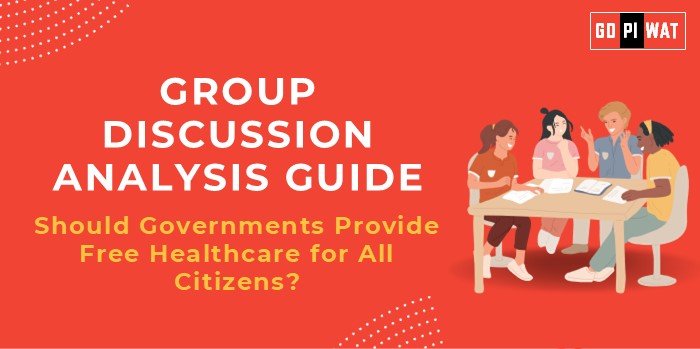📋 Group Discussion Analysis Guide: Should Governments Provide Free Healthcare for All Citizens?
🌐 Introduction
Opening Context: “The question of universal free healthcare highlights a global debate on social responsibility versus economic feasibility, emphasizing its importance for the well-being and equity of citizens.”
Background: Universal healthcare aims to ensure that every citizen has access to essential health services without financial hardship. This model has been adopted successfully in countries like Canada, the UK, and Norway, but remains contentious in others due to economic and political constraints.
📊 Quick Facts and Key Statistics
– 🇮🇳 India’s Healthcare Spending: 2.1% of GDP (National Health Accounts, 2023) – Among the lowest for major economies.
– 💰 Medical Debt Impact: Over 50% of personal bankruptcies in the US are linked to healthcare costs (2022).
– 👶 Life Expectancy Comparison: Countries with universal healthcare systems like Japan (84 years) have higher average life expectancy than those without (e.g., the US, 77 years).
🤝 Stakeholders and Their Roles
- 🏛️ Government: Policy formulation, funding, and infrastructure development.
- 🏥 Healthcare Providers: Deliver quality services efficiently and ethically.
- 👥 Citizens: Demand accountability and utilize services responsibly.
- 💼 Private Sector: Offer supplementary services, R&D, and innovation.
- 🌐 International Organizations: Provide technical and financial support.
🏆 Achievements and Challenges
✨ Achievements
- ✅ Improved Public Health: Nations with universal healthcare like Norway report lower infant mortality rates (1.7/1,000 births).
- 💸 Cost Control: Canada spends less per capita ($5,000/year) than the US ($11,000/year) while covering all citizens.
- ⚖️ Social Equity: Reduces income-based health disparities.
⚠️ Challenges
- 💰 Funding Limitations: Developing nations often struggle to allocate sufficient resources.
- 📉 Quality Concerns: Risk of overcrowding and reduced service quality.
- 🏛️ Political Resistance: Polarization around tax increases for funding.
🌍 Global Comparisons
- 🇳🇴 Success in Scandinavia: Norway and Sweden show high satisfaction with healthcare access.
- 🇺🇸 Challenges in the US: The Affordable Care Act faced resistance, leaving 8% of Americans uninsured (2023).
💡 Case Study
🇮🇳 Kerala, India: Free healthcare model achieves a life expectancy of 75 years, among the highest in the country.
💬 Structured Arguments for Discussion
Supporting Stance: “Healthcare is a fundamental right. Universal free healthcare reduces inequality and fosters a productive workforce.”
Opposing Stance: “Free healthcare strains government resources, leading to inefficiencies and lower service quality.”
Balanced Perspective: “While universal healthcare is ideal, hybrid models combining public and private participation might be more feasible for developing economies.”
📚 Effective Discussion Approaches
- 📊 Opening Approaches:
- 💡 Statistical Impact: “With over 100 million Indians pushed into poverty annually due to healthcare costs, is universal care the solution?”
- 🌍 Comparative Insights: “Countries with universal healthcare consistently rank higher in life expectancy and happiness indices.”
- 🤝 Counter-Argument Handling:
- ✅ Example: “Acknowledging financial concerns, innovative funding mechanisms like public-private partnerships can mitigate fiscal burdens.”
🔍 Strategic Analysis of Strengths and Weaknesses
– ⚠️ Weaknesses: Initial funding challenges, quality risks.
– 🌟 Opportunities: Public-private collaborations, technological advancements.
– 🚧 Threats: Political resistance, implementation inefficiencies.
📈 Connecting with B-School Applications
- 🌍 Real-World Applications: Analyze the economics of healthcare for operational and development projects.
- ❓ Sample Interview Questions:
- 💬 “Discuss the feasibility of universal healthcare in India.”
- 💡 “How can private players contribute to public healthcare?”
- 📖 Insights for B-School Students:
- Explore healthcare financing, policy-making, and ethical dimensions for internships and projects.


